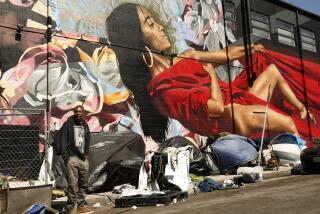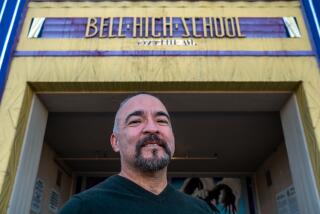Garcetti, in yearly address, pushes new tax to support L.A. schools

Los Angeles Mayor Eric Garcetti used his annual State of the City address Wednesday to make an extended sales pitch for Measure EE, a new tax for public schools that faces sharp opposition from the region’s business groups.
Garcetti, who has put significant political capital into passage of the tax, said the measure would allow the Los Angeles Unified School District to lower class sizes, keep school libraries open, and staff campuses with nurses and counselors. The alternative, he argued, would be layoffs of teachers and school support staff within the next two years.
“There will always be those who claim that funding our schools is a waste of money. But our children are not a waste of money,” Garcetti told the audience at Lincoln High School in Lincoln Heights.
The address was the mayor’s first State of the City speech since he abandoned the idea of a long-shot campaign for president in 2020. And it offered the latest sign of Garcetti’s shift in emphasis toward issues confronting public schools.
Garcetti helped broker an end to the six-day strike in January by United Teachers Los Angeles, the union that represents educators at L.A. Unified. He and two of his top advisors are working to pass Measure EE, which is on the June 4 ballot and would collect an estimated $500 million a year for the school district.
The mayor also has been a presence in the race to replace former school board member Ref Rodriguez, who stepped down after pleading guilty to political money laundering, in a district stretching from Los Feliz to South Gate. He endorsed former city commissioner Heather Repenning, a longtime aide and political ally, in her race against Jackie Goldberg, a former member of the school board and council.
Wednesday’s speech also touched on several City Hall initiatives, including the creation of a new “jobs cabinet,” an expansion of community policing, a new program to assist vulnerable renters and an array of policies aimed at addressing climate change.
Garcetti touted the city’s work in developing a Green New Deal within L.A., saying no one will care about potholes if “Venice is underwater.” He also highlighted his recent decision to have the Department of Water and Power abandon plans for rebuilding three natural gas power plants.
That move drew protests outside Lincoln High School from members of the International Brotherhood of Electrical Workers Local 18, which represents DWP employees.
Garcetti also acknowledged the public’s frustration with the slow pace of progress addressing homelessness, attributing it in part to neighborhood opposition.
Although the city has scores of supportive housing projects with nearly 7,000 units in the pipeline, the city still has not yet opened a project funded with proceeds of Proposition HHH, which was passed in 2016 to help address homelessness. The first is expected to open later this year.
Still, the centerpiece of the speech was about education, both rhetorically and in substance.
Garcetti defined this year’s teachers’ strike as a latter-day incarnation of a struggle for justice and equity. And he noted that 28% of children in Los Angeles County live in poverty.
The mayor’s education efforts are already facing major tests. Goldberg led Repenning by a huge margin in the school board primary election, and is now viewed by many as a strong favorite. Meanwhile, more than a dozen business groups have lined up against Measure EE, which needs a two-thirds majority to pass.
Last week, the leader of one of those groups accused a high-level Garcetti advisor of making threats over their opposition to the new tax. The advisor, Rick Jacobs, denied the allegations.
Minutes after the speech ended, Chip Ahlswede, chief executive of the Beverly Hills Greater Los Angeles Assn. of Realtors, issued a statement calling Measure EE “the wrong solution” to the school district’s woes.
“Measure EE does not guarantee that funding goes toward children or into the classroom,” he said. “In fact, it’s more likely that our hard-earned tax dollars will be used to fund retiree pension debt and health costs, more bureaucrats and more consultants.”
Measure EE is structured to fall heavily on businesses and owners of large apartment complexes, because it is based on the square footage of enclosed space. A private hospital, for example, would be taxed for every square foot of every floor.
Had the tax been structured as a flat tax on every parcel, more business leaders might have supported it. Instead, opponents have argued that the school district has not taken aggressive internal steps to address its financial problems.
Backers of Measure EE say it would result in an additional $160 per year in taxes for the owner of a 1,000-square-foot house. Much of the parcel tax’s proceeds would be needed to plug a budget deficit rather than going entirely to such popular measures as shrinking the size of classes.
If approved, the tax measure is slated to expire in 12 years.
For years, Garcetti mostly shied away from controversial stands on public schools, making a sharp break from Mayor Antonio Villaraigosa, his predecessor. Villaraigosa, while serving as mayor, won passage of a bill in Sacramento allowing a municipal takeover of L.A. Unified, only to see the legislation struck down in court.
Undaunted, Villaraigosa worked to elect a slate of candidates to the school board, who then installed a superintendent he favored. And, with the district’s approval, he helped launch a nonprofit to run some of the city’s lowest-performing schools.
Garcetti, by contrast, focused more in his early years on raising money for city-sponsored after-school programs and summer youth activities. Unlike Villaraigosa, he has tried to avoid being associated with either of the two factions vying for control of the school board — the teachers’ union or backers of charter schools.
In his speech, Garcetti highlighted education proposals in line with his well-received but non-controversial past efforts. For younger students, the mayor said the city would be involved with the county and L.A. Unified to train 2,500 early childhood educators, something that he said would help address the “school readiness gap” between the haves and the have-nots.
Garcetti also announced an expansion of L.A.’s Best, a longstanding after-school program, to provide activities and tutoring to an additional 20 campuses – and some 1,200 students – over the summer.
In addition, he said, 29 campuses would receive city funding to be open as parks on weekends by 2025. Currently, there are four schools in the program.
Times staff writer Emily Alpert Reyes contributed to this report.
More to Read
Start your day right
Sign up for Essential California for news, features and recommendations from the L.A. Times and beyond in your inbox six days a week.
You may occasionally receive promotional content from the Los Angeles Times.









